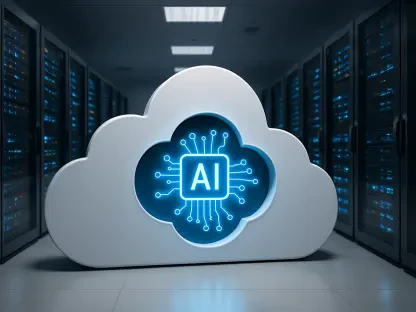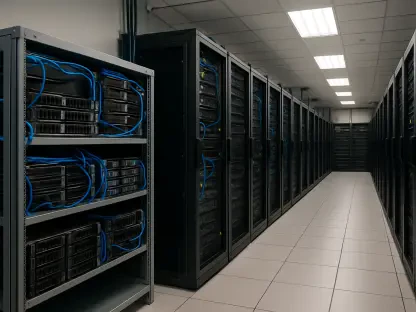As the world increasingly relies on digital services for nearly every aspect of daily life, the hidden environmental costs of our digital dependency are coming to the forefront. Data centers, the backbone of modern cloud computing and digital interaction, are under scrutiny for their massive water consumption. This burgeoning issue demands immediate attention as the technology sector grapples with the challenge of sustaining digital growth while adhering to environmental responsibilities. Giants like Google, Amazon, and Microsoft have propelled forward the digital revolution, yet their data centers consume volumes of water that raise serious concerns about sustainability and resource allocation, especially in areas already plagued by water scarcity.
Reflecting on Data’s Water Footprint
Digital Necessities and Vast Water Needs
In a world where every online click or AI-generated response carries an unseen environmental toll, understanding the true water cost of digital activities is essential. Despite the virtual nature of a Google search or a social media post, these actions are supported by data centers consuming vast quantities of water globally to facilitate seamless user experiences. The indispensable utility of data centers, encompassing services from streaming to email, comes at a steep environmental price. As these infrastructures function round the clock, the water dependency of digital services is intricately tied to their operational sustainability, presenting a pressing challenge for tech companies to address.
The physical realities of data centers take center stage when considering their cooling techniques—a critical factor in their water usage. Behind the seamless operation of digital services lies a need to effectively manage high server temperatures. Traditional air cooling systems fall short when facing increasing heat loads, propelling a transition to water-based cooling systems. While water cooling proves more efficient, it significantly amplifies the demand for water resources. Consequently, the industry’s reliance on water becomes a focal point as it endeavors to balance technological efficiency with ecological responsibility. The persistent demand for cooling highlights the urgent need for innovative and sustainable solutions to mitigate the environmental impact.
Exploring Water Sources and Sustainable Alternatives
The water consumption narrative of data centers is primarily linked to their water sourcing strategies. Predominantly reliant on municipal water supplies, a limited number of data centers integrate recycled or alternative water sources into their operations. The extensive use of potable water raises concerns, particularly in water-scarce regions where competition for resources can become contentious. Although some industry leaders have begun leveraging technologies that incorporate reclaimed water, the prevalent use of municipal supplies underscores a significant opportunity for the sector to innovate and shift toward more sustainable practices, promising a tangible reduction in the environmental footprint.
Adopting alternative water sources introduces complexities as centers navigate challenges like mineral buildup and conductivity in recycled water systems. Nevertheless, the exploration of closed-loop systems and wastewater recycling has proven potential to significantly curb water dependence. As environmental stewardship becomes increasingly vital, the tech industry’s investment in these pioneering solutions reflects a commitment to sustainability. The transition from relying solely on standard water sources to proactively seeking environmental solutions speaks volumes about the industry’s pivot toward eco-friendly operations, setting a precedent for future practices. This trend augurs well for a new era of technological growth intertwined with environmental mindfulness.
AI’s Role in Escalating Water Demands
Examining AI’s Influence on Water Utilization
The exponential growth of AI has ushered in a new era of data processing demands, indirectly amplifying the pressure on data centers and their water consumption. AI’s transformative impact is seen in increased computational requirements, necessitating enhanced cooling capacities. This escalation in cooling needs directly translates to heightened water use, posing a formidable challenge for the technology sector to meet AI innovation without compromising water conservation. As AI systems require extensive computing power, the consequential demand for water heightens the necessity for data centers to invest in cutting-edge cooling technologies that balance performance with sustainability.
In the context of AI, understanding its water footprint becomes paramount as projections suggest a substantial rise in water usage linked to AI operations. Industry estimates indicate that AI’s contribution to water consumption could reach billions of gallons annually. This daunting figure underscores a critical need for preemptive strategies to address the water demands of AI advancements. The pursuit of alternative cooling methodologies and the integration of AI-specific resource management solutions emerge as essential pathways in mitigating the environmental implications. As AI continues to evolve, its synergy with water conservation strategies will play a pivotal role in shaping the future of data center operations.
Exploring Efficient Cooling Technologies
Amidst the rising water demands spurred by AI advancements, the evolution of cooling technologies presents a promising solution for reducing environmental impact. Liquid cooling solutions, once limited by cost, are now gaining traction for their efficacy in direct temperature management. These advanced systems enable more efficient heat dissipation, reducing reliance on traditional water-based cooling. Simultaneously, innovations like immersion cooling are emerging as viable alternatives, offering pathways to drastically cut water consumption. These cutting-edge technologies concurrently address the demands of AI processing speed while prioritizing sustainability, embodying the balance between technological progress and ecological preservation.
The quest for water-efficient cooling solutions is not merely an aspiration but a necessity as data centers brace for increased AI-driven demands. Investments in research and development in cooling technologies reflect a wider commitment within the industry towards minimizing water footprints. These endeavors highlight a proactive approach, aligning technological expansion with environmental conscientiousness. As cutting-edge cooling methods gain momentum, their adoption signifies a transformative shift toward sustainability-conscious operations. This evolution not only mitigates the prolonged dependency on water-intensive practices but also sets a new environmental benchmark for future technological developments.
Societal and Environmental Consequences
Navigating Resource Conflicts and Community Concerns
As data centers continue to expand, their water consumption often puts them at odds with local communities and industries in resource-constrained areas. Particularly in regions suffering from limited water availability, data centers face criticism for competing with agricultural needs and community water supplies. The environmental and social impacts of data centers pose significant challenges as they navigate the delicate balance between operational demands and the needs of surrounding ecosystems and people. The occurrence of protests and mounting opposition to data center expansions illuminates the imperative for the tech sector to carefully consider resource allocation and community cooperation.
The forecast that over half of the global population might struggle with water scarcity within the next few years stresses the need for sustainable operational models within the technology sector. How data centers manage their water resources will play a pivotal role in shaping their relationships with host communities and defining their contributions to broader societal goals. Efforts to establish transparency, engage in open dialogues with local stakeholders, and emphasize water conservation are crucial steps the industry is taking toward fostering harmonious coexistence. Navigating resource conflicts with a community-focused approach reflects the industry’s broader ambition for sustainable development and societal integration.
Advancing Accountability and Transparency
Despite the significance of data centers’ water usage, current metrics for evaluating their water impact remain lacking, preventing a comprehensive understanding of their environmental footprint. Transparent reporting and metric expansion involving indirect water consumption from energy generations are essential for gaining insights into data centers’ true impact. Enhanced metrics like water usage effectiveness (WUE) are crucial tools that can shed light on water resource utilization, further paving the way for informed strategies that mitigate adverse effects. By prioritizing accountability, tech companies can take substantial strides toward ethical environmental stewardship in their operations.
In enhancing transparency, the establishment of comprehensive benchmarks for water reporting and usage remains a critical priority. The integration of robust frameworks and guidelines for environmental sustainability offers the potential for unified sector standards. Such initiatives incentivize responsible water usage practices and facilitate a clear understanding of the industry’s impact on global water resources. As the focus sharpens on industry accountability and clarity, tech companies are setting benchmarks for transparency and measurement, fostering trust among stakeholders and aligning operational strategies with broader environmental priorities.
Industry Innovations and Sustainable Commitments
Pursuing Water Positivity Goals
Against a backdrop of escalating environmental concerns, technology firms are dedicating resources and innovation to foster sustainable water management practices. Pledges to achieve “water positive” operations by the decade’s close mark a fundamental shift toward environmental accountability. Leading firms, notably Amazon, commit to substantial water restoration projects, while Microsoft ambitiously aims to curtail water utilization in evaporative cooling. These initiatives serve as critical steps in the ongoing efforts to balance operational excellence with ecological preservation, setting a framework for industry-wide sustainability targets.
These commitments indicate an essential shift in corporate priorities, recognizing the interdependence of technology growth and environmental welfare. The recognition that water considerations are integral to long-term business strategies underscores a broader shift toward embedding sustainability at the core of technological operations. By implementing practical steps toward collective water positivity, firms are paving the way for innovative water stewardship throughout the tech industry. The actions of these industry leaders not only inspire peers but also signal to the global audience their resolve to integrate responsible environmental practices into the digital fabric.
Exploring Novel Approaches to Water Conservation
Amidst the unveiling of high-profile environmental commitments, companies are rigorously pursuing innovative solutions to address water consumption challenges. Exploration of rainwater harvesting, wastewater recycling, and closed-loop systems heralds a new era of water conservation aimed at minimizing freshwater dependence. These approaches, coupled with the adoption of emerging cooling technologies, provide promising avenues for significantly reducing water footprints. Such forward-thinking initiatives signal the tech industry’s intent to effect significant environmental change, ensuring a sustainable trajectory for digital growth and operational efficiency.
These technological advancements, seamlessly integrated into industry practices, represent more than just operational improvements—they exemplify a paradigm shift toward a sustainable future. As the industry harnesses novel methodologies, it acknowledges the increasing social and environmental responsibilities associated with its digital advances. By prioritizing resource conservation, the sector strengthens its resolve to manage water sustainability challenges proactively. In paving the way for future essential practices, the tech sector demonstrates its capacity to reconcile growth with eco-conscious innovation, establishing a template for progressively harmonizing digital expansion with environmental conservation.
A Roadmap for Future Balance
As society becomes more dependent on digital services for nearly every facet of daily living, the hidden environmental toll of this digital dependency is coming to light. Central to this concern are data centers, the critical infrastructure that underpins modern cloud computing and digital interactions. These facilities are now facing scrutiny for their significant water usage, a growing issue that requires urgent attention as the tech industry struggles to balance digital expansion with environmental stewardship. Leading companies such as Google, Amazon, and Microsoft have been at the forefront of the digital age, spearheading technological advancements and driving considerable change. However, their vast data centers are in the spotlight due to the substantial amounts of water they consume, which pose serious questions about sustainability and resource management, particularly in regions that are already dealing with water shortages. As digital transformation continues to accelerate, finding ways to reduce the environmental footprint of data centers is becoming increasingly critical. Solutions may lie in innovative technologies or refined strategies that ensure digital growth is not achieved at the expense of our planet’s invaluable resources.









